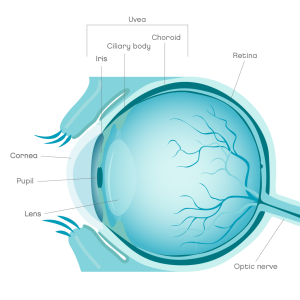Uveitis in dogs can lead to blindness if left untreated. Dogs that are squinting should have their eyes checked by a vet. Golden retrievers may be prone to this condition.
Uveitis is inflammation of the middle area of the eye (uvea), which includes certain tissues within the eye. Depending on the affected tissues, this condition can be called anterior uveitis, posterior uveitis, or panuveitis. Uveitis in dogs usually has an unknown cause.
Overview
What is uveitis in dogs?
The eyes are complex structures. The middle layer, called the uvea, includes the following:
- Iris: colourful muscular ring that surrounds the pupil
- Ciliary body: the structure that holds the lens in place
- Choroid: layer of tissue that supplies blood to the retina
This painful condition can affect the front of the eye (anterior uveitis), the back of the eye (posterior uveitis), or the entire uvea (panuveitis).

Uveitis can be caused by conditions originating on or outside of the eye (systemic problems):
- Ulceration or inflammation of the cornea
- Trauma/injury to the eye
- Infectious conditions
- Bacterial diseases: brucellosis, leptospirosis, tick-borne diseases (such as Lyme disease)
- Systemic fungal disease
- Autoimmune disease (disease where the dog produces antibodies against its own tissues)
- Tumour
- Unknown origin (idiopathic)
Regardless of the underlying cause, uveitis is very painful and requires prolonged treatment that can last weeks to months.
An early diagnosis of uveitis and any underlying disease is crucial to prevent secondary glaucoma (a painful increase in pressure within the eye) or permanent blindness.
Taking your dog to an eye specialist vet in a referral hospital is usually necessary.
Symptoms
What are the signs of uveitis in dogs?
You might notice some or all of the following in your dog:
- Squinting
- Light sensitivity
- Producing more tears
- The third eyelid is more visible (inner eyelid at the inside corner of the eye)
- Pawing or rubbing the eye(s)
- Red or cloudy eye(s)
- Vision changes or blindness
- Other non-ocular signs, such as enlarged lymph nodes, fever, and others (depending on underlying disease)
Risk
Are some dogs more at risk of uveitis?
Uveitis can affect any dog, regardless of breed or age.
But it seems that Golden Retrievers may have a particular predisposition.
Are there any human health concerns to consider?
Uveitis does not pose a risk to humans, but certain infectious causes of uveitis may be contagious to humans (zoonotic).
These can include Brucellosis, Leptospirosis and others.
Talk with your healthcare provider if your pet is diagnosed with a zoonotic condition.
Diagnosis
How is uveitis diagnosed?
Uveitis is diagnosed by:
- Taking your dog’s medical signs and travel history
- Eye examination using a light source
- Testing the pressure inside the eye
- Dye test
- Tear production test
- Pupil enlargement test: a drop of medicine is applied to both eyes to enlarge the pupils for better visualisation of the back of the eye.
To check for other illnesses affecting the body and the eyes, your vet may recommend the following:
- Blood tests
- Urine test
- Blood pressure test
- Infectious disease blood testing
- Ocular ultrasound scan
- Radiographs (x-rays)
- Abdominal ultrasound scan
- FNA (fine needle aspiration test): small needle test used to collect a sample of the cells from a lymph node or mass present on the skin
Vet treatment
What is the treatment for uveitis in dogs?
Treatment of uveitis is initially focused on reducing inflammation and providing pain relief.
Then, further treatment will be based on your dog’s underlying disease or specific needs.
Your vet might recommend one or more of the following:
- Topical (applied to the surface) anti-inflammatory eye ointments or drops.
- Additional topical eye medications such as antibiotics, corticosteroids, atropine (a drug to dilate the pupil), or lubricating drops.
- Oral (by mouth) painkiller medication.
- Other treatments specific to each underlying cause (antibiotics, chemotherapy, or surgery).
- Surgical removal of the eye (enucleation) is usually recommended for dogs with severe glaucoma or tumours in the eye.
With early diagnosis and treatment, most cases start improving within a day or two, but the ultimate outcome will depend on the underlying cause.
Home treatment
Home care for a dog with uveitis
Eye discharge should be gently wiped away from the eyes on a daily basis.
- You can use sterile eye wash or appropriate eye wipes.
Home monitoring and frequent vet rechecks are expected to ensure treatment is working.
- Vet checks can be needed weekly until fully resolved or, in some cases, in a shorter time frame.
Make sure to give and apply all medication as advised by your vet.
- Missed doses can lead to a longer recovery period.
Prevention
Can uveitis in dogs be prevented?
Routine vaccination prevents several infectious causes of uveitis.
Routine parasite preventive medications can help protect against infectious organisms in high-risk areas.
Follow your vet’s advice on how to travel safely with your dog. Extra precautions are needed when you are abroad.
When to worry
When do you need to worry about your dog with uveitis?
Call a vet as soon as possible if your dog:
- Does not improve despite treatment
- Has changes in their vision
- Is in pain
Joii can help with advice on:
- Identifying pain in your dog
- How to apply and give medication
- Caring for a dog after eye surgery
- Cleaning your dog’s eyes








